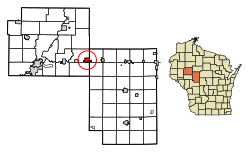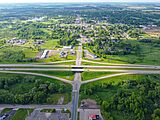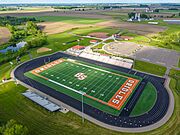Stanley, Wisconsin facts for kids
Quick facts for kids
Stanley, Wisconsin
|
|
|---|---|

Old downtown, facing north
|
|

Location of Stanley in Chippewa County
and Clark County, Wisconsin. |
|
| Country | |
| State | |
| Counties | Chippewa, Clark |
| Area | |
| • Total | 4.33 sq mi (11.22 km2) |
| • Land | 4.26 sq mi (11.05 km2) |
| • Water | 0.07 sq mi (0.18 km2) |
| Elevation | 1,083 ft (330 m) |
| Population
(2020)
|
|
| • Total | 3,804 |
| • Density | 878.5/sq mi (339.04/km2) |
| Time zone | UTC−6 (Central (CST)) |
| • Summer (DST) | UTC−5 (CDT) |
| Area code(s) | 715 & 534 |
| FIPS code | 55-76625 |
| GNIS feature ID | 1574790 |
Stanley is a city in Wisconsin, located in both Chippewa and Clark counties. In 2020, about 3,804 people lived here. Most of Stanley is in Chippewa County.
Contents
Discovering Stanley's Past
Stanley was first settled in 1881. This happened when the Wisconsin Central Railroad built its tracks through Chippewa County. The town was named after Lemuel C. Stanley. He was a merchant and railroad worker from a nearby town.
Early Industries and Growth
At first, Stanley's main businesses were a small sawmill and places to make charcoal. These were built in 1887. In 1891, the Northwestern Lumber Company opened a huge lumber mill in Stanley. This company used to cut wood near Eau Claire. But they had cut down most of the trees near rivers. So, they changed to using railroads to move logs.
The company built a new mill in Stanley. They also created the Stanley, Merrill and Phillips Railway. This railway helped bring logs from the forests. The mill in Stanley cut wood until 1920. By then, most of the trees in the area were gone. Over the years, the mill cut a massive amount of lumber.
Stanley grew a lot in the 1890s. Its population went from 500 to 2500 people. Stanley became a village in 1895. It became the City of Stanley in 1898.
In 1897, a company called U.S. Leather opened a tannery in Stanley. A tannery is a place that turns animal hides into leather. This business hired 200 men. It processed many hides from places like Chicago and South America.
Another big early business was the Big Four Canning Factory. Farmers brought their crops like peas, cabbage, and corn there. In 1914, this factory made up to 100,000 cans of vegetables every day. They shipped these cans all over the country.
The Great Fire of 1906
On May 18, 1906, a big fire started in Stanley. It began in a lumber company building. The fire quickly spread to other businesses and homes. It destroyed many buildings, two churches, and about seventy houses. But people in Stanley helped each other. Businesses rebuilt, often using fireproof bricks. The city recovered and moved forward. The Northwestern Lumber Company had a brickyard that made bricks. After the fire, they made many more bricks to help rebuild Stanley.
Recent Events
In 2002, Stanley added some land from the Town of Thorp in Clark County. On December 15, 2021, a strong tornado hit the city. It damaged several buildings, including the old train depot. Luckily, no one was hurt.
Stanley's Location
Stanley is located at about 44.96 degrees North and 90.93 degrees West. The city covers about 4.25 square miles (11.0 square kilometers). Most of this area is land, with a small amount of water. Stanley is mainly on the north side of Wisconsin State Highway 29. It is mostly in Chippewa County, but some parts on the east side are in Clark County.
Population Changes in Stanley
| Historical population | |||
|---|---|---|---|
| Census | Pop. | %± | |
| 1900 | 2,387 | — | |
| 1910 | 2,675 | 12.1% | |
| 1920 | 2,577 | −3.7% | |
| 1930 | 1,988 | −22.9% | |
| 1940 | 2,021 | 1.7% | |
| 1950 | 2,014 | −0.3% | |
| 1960 | 2,014 | 0.0% | |
| 1970 | 2,049 | 1.7% | |
| 1980 | 2,095 | 2.2% | |
| 1990 | 2,011 | −4.0% | |
| 2000 | 1,898 | −5.6% | |
| 2010 | 3,608 | 90.1% | |
| 2020 | 3,804 | 5.4% | |
| U.S. Decennial Census | |||
In 2010, there were 3,608 people living in Stanley. The city has a diverse population. There were 930 households in the city. About 30% of these households had children under 18.
Healthcare in Stanley
Stanley has Aspirus Stanley Hospital. This hospital has 24 beds and is a level IV trauma center. This means it can provide initial care for serious injuries. The area needs more doctors, especially for general health and mental health. There are fewer doctors per person in Stanley compared to the rest of Wisconsin.
Education for Kids
Students in Stanley and the nearby village of Boyd go to schools in the Stanley-Boyd School District. This includes Stanley-Boyd Elementary School, Stanley-Boyd Middle School, and Stanley-Boyd High School. The high school has about 332 students. For sports, the high school is part of the Cloverbelt Conference.
Stanley Correctional Institution
The city is also home to the Stanley Correctional Institution. This is a prison facility.
Famous People from Stanley
- Robert Whitney Burns: A Lieutenant General in the U.S. Air Force.
- Dave Cahill: Played football for teams like the Philadelphia Eagles.
- Clarence B. Culbertson: A Wisconsin State Representative.
- George H. Hipke: A Wisconsin State Senator.
- Larry Krause: Played for the Green Bay Packers.
- Vincent Mroz: A Secret Service agent.
- David Plombon: A Wisconsin State Representative.
- Terry A. Willkom: A Wisconsin State Representative.
Images for kids
See also
 In Spanish: Stanley (Wisconsin) para niños
In Spanish: Stanley (Wisconsin) para niños






